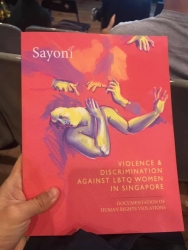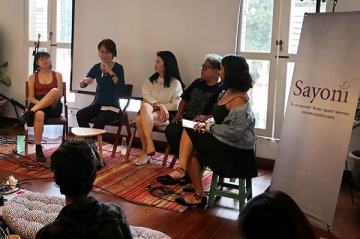I cannot speak for gay men, but lesbians do not like bisexuals. That is very much clear, from the general attitude. They are perpetually afraid of their partners leaving them for The Man, ‘the enemy’.
This author finds that a really sad situation, because, as she has elucidated before, Men are not the enemy. It is our own attitudes, our insecurities, which are the problem. If your partner leaves you for a man, how different is it from her leaving you for another woman?
The lesbian community is selfish: once a woman says she likes women a bit more than men, she is automatically branded as lesbian and claimed triumphantly, a tiny victory over the other side. And the unforunate girls who are on the other side of 3 are called fly-by straight girls. Are there only two (or three) categories for a person to ascribe to?
Here, Pleinelune would like to introduce two new terms of her own invention: “true-type” bisexuals, and “generic bisexual”. The true-type bisexual is someone who is between a 2.5-3.5 on the Kinsey scale [rated from 0 to 6]. The generic bisexual is someone who falls outside this range, but not 0 or a 6 – this is the average person on the street. Keeping this classification in mind will help us clarify many issues surrounding bisexuality, a much misused and misunderstood term.
Pleinelune is a true-type bisexual, and would like to clarify that she has never found it necessary to ‘make up her mind’ between men and women ‘ she takes whoever who comes along who fits her profile, guy or girl. The same, I believe, would hold true for many true-type bisexuals, who truly prefer boys and girls to more or less to the same extent, give or take a few percentage points. To this day, she has refused to answer the age-old question every lesbian seems to ask her: do you like men or women more? To her, this question is irrelevant, because, as mentioned before, she takes whoever who comes along, regardless of gender.
Then there is misconception that many people call themselves bisexual in their coming out phase, only to transition into being completely gay. While this phenomenon does happen and is completely understandable – true-type bisexuals are often accused of this, though the real “culprits” are generic bisexuals. And there are the those who have adviced Pleinelune that she will eventually turn gay or straight – these people she ignores, for they are still stuck in a binary system. It is already clear sexuality is not a discrete variable, but a continuous one.
To most gay people, the prospect that someone can be swinging in between two worlds is scary, because, they are afraid that the world they’ve built for themselves, the identity they ascribe to themselves, the way they assert how the opposite sex does not turn them on, will come crashing down when someone points to bisexuals. After all, the acceptance of the gay community hinges on the fact that ‘they are born that way’, and that they ‘cannot change’. Bisexuals, it seems, form the chink in the armour of their defence mechanism, with their ability to move in between worlds.
Pleinelune’s rebuttal is, bisexuals are ‘born that way’ too. So if you are to lambast the bisexual identity, then you are chopping away at the roots of your own identity.
Being in the no-man’s land between gay and straight is hard – we not only get discriminated by straight people with the same bigoted attitude, but also gay people. There is adequate discrimination against us as a gay community – is there any use dividing up our tiny community further with labels, stereotypes and sheer idiocy [such as Ms Gardner's article]?
In the last part of this series, Pleinelune shall discuss the nemesis of lesbians everywhere: the bicurious woman.




Comments
jade said,
April 16, 2006 at 9:52 pm
oh gawd the trinary!! my eyes are burning!!
pleinelune said,
April 16, 2006 at 10:44 pm
Trinary? *blinks*
encloset said,
April 16, 2006 at 11:04 pm
*standing ovation*
here here!
Michelle said,
April 18, 2006 at 5:46 am
Thanks for a really great article! Very refreshing reading.
Mier said,
April 18, 2006 at 8:50 pm
Waiting in anticipation for your last article~ =)
pleinelune said,
April 18, 2006 at 9:34 pm
Thanks everyone. :) Time someone started clearing the air about this… and the next article will be very interesting, I promise!
jade said,
April 19, 2006 at 12:46 am
on a seperate note, beware of using kinsey. he’s a respected sociological figure but his studies were flawed.
Mier said,
April 19, 2006 at 9:34 am
Flawed… that’s interesting. Can you tell us how his studies are flawed?
jade said,
April 19, 2006 at 4:26 pm
uhm, it’s a well-known fact. a google search should turn up something.
:)
Mier said,
April 19, 2006 at 5:06 pm
Er… so well-known that you need to caution us not to use his studies; to alert us to the flaws of his studies?
I have yet to take note of his name! lol. Oops~
Sounds like the flaws cannot be put in a few words…
Mier said,
April 19, 2006 at 5:26 pm
Hey peeps, if you are interested in the Kinsey thingy, you can read this:
“Even the very real flaws in Kinsey’s studies–his tendency toward Skinnerian reductionism, his relatively unsophisticated statistical methods–are magnified beyond recognition. Many people, for instance, “know” that Kinsey is responsible for the “discredited” claim that 10 percent of the population is gay. But he never said any such thing: His actual claim was that about 4 percent are exclusively homosexual, while 10 percent are predominantly homosexual for periods of two years or more.
It’s well known that Kinsey’s extensive sample of sexual histories–still used as a benchmark for contemporary sex researchers–relied too heavily on subjects in prisons or mental hospitals, a fact he belatedly recognized and attempted to correct in Sexual Behavior in the Human Female. Less well known is that one of his colleagues, Paul Gebhard, re-examined the data sets in Human Male with those suspect histories excluded and found that the effect on Kinsey’s conclusions was insignificant.
It’s easier to focus on Kinsey’s flaws because so many of his then-radical findings–adolescent masturbation all but ubiquitous! premarital sex rampant! married couples performing oral sex! millions of gays among us!–now seem so obvious as to barely deserve mention. But some of Kinsey’s other discoveries, though uncontroversial among professionals in the field, remain unassimilated.
At a preview screening of the film in Washington, D.C., director Condon offered the surprising opinion that Kinsey would have had strong reservations about the contemporary gay movement. Americans still tend to think of sexuality in binary terms: a world of absolute straights and gays, with the mysterious bisexual tacked on as an afterthought. Kinsey mapped sexual orientation on a seven-point scale, on which exclusive heterosexuality and homosexuality were only the extremes–a scale further developed by later researchers. That view has penetrated popular consciousness far less than Kinsey’s other findings. (Some gay activists may fear that a less rigidly binary view of sexuality would give ammunition to traditionalists: “If it’s all a fluid continuum, then why can’t you change?”)
Kinsey’s more complex picture of sexuality reveals that, in a sense, even the term gay rights is unfortunate. After all, we don’t refer to free speech as “political agitators’ rights.” Perhaps a more Kinseyan conception would encourage us to recognize “gay rights,” if we must use the term, as rights we all enjoy, whether or not we care to exercise them.
The tendency to make sexual politics into identity politics may have been exacerbated by Kinsey’s own strategy of focusing on the prevalence of different sexual behaviors–homosexuality, masturbation, sado-masochism–on the theory that “everybody’s sin is nobody’s sin.” The doctor’s thought is well-intentioned, but it doesn’t make much sense. Philately is doubtless more aberrant than deception, but that tells us nothing about their relative morality.
Better is the lesson Condon’s Kinsey offers in one of his lectures on gall wasps: “If every living thing is different, then diversity becomes life’s irreducible fact.” Kinsey tried to tell America that all sexual behavior is normal. A better lesson might be that, in the bedroom and elsewhere, we’re all fantastically weird.
Julian Sanchez ([email protected]) is assistant editor of reason.”
http://www.findarticles.com/p/articles/mi_m1568/is_9_36/ai_n13490297
jade said,
April 19, 2006 at 6:30 pm
Like how Foucault and Angelides strive for the destruction of sexual identities, as do most in the study of social construction of reality.
Kinsey’s data was fundementally flawed, no matter how much an apologetic proposition we might try to take. His study however, gave leeway in the study of sexology, allowing it to be less of taboo subject as it was previously.
Interestingly, it was his study on the behaviour of women that led to his downfall..
pleinelune said,
April 19, 2006 at 8:38 pm
Whatever the other flaws of his work were, I firmly believe the Kinsey scale is pretty accurate, both from anecdotal evidence and studies done on the general population. It provides the best explanation for the wide variety of sexual behaviours and orientations.
lublub said,
April 19, 2006 at 10:45 pm
actually jade,
what do u mean when u said the Kinsey studies are flawed? Cos i dun really know much abt Kinsey, only that yes he did some sexuality studies etc..
jade said,
April 20, 2006 at 12:06 am
His data pool was massively biased. He studied a large number of people from prisons and environments where homosexual behaviour had a higher chance of occuring – i’m writing this from info at the top of my head so i can’t be sure, i’m forgetful, but that’s mostly it.
As for the kinsey scale, yes, i agree it’s a good measure, but with the advancement of sexology and related fields, i believe there are growing number of ways to gather data.
Sayoni Speak » Bisexuality � The Curious Cat said,
April 26, 2006 at 7:21 pm
[...] Last week, Pleinelune examined the problems bisexuals face. In the last part of this series, she explores the nemesis of lesbians everywhere: the bicurious woman. [...]
RSS feed for comments to this post